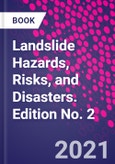Landslide Hazards, Risks and Disasters Second Edition makes a broad but detailed examination of major aspects of mass movements and their consequences, and provides knowledge to form the basis for more complete and accurate monitoring, prediction, preparedness and reduction of the impacts of landslides on society. The frequency and intensity of landslide hazards and disasters has consistently increased over the past century, and this trend will continue as society increasingly utilises steep landscapes. Landslides and related phenomena can be triggered by other hazard and disaster processes - such as earthquakes, tsunamis, volcanic eruptions and wildfires - and they can also cause other hazards and disasters, making them a complex multi-disciplinary challenge.
This new edition of Landslide Hazards, Risks and Disasters is updated and includes new chapters, covering additional topics including rockfalls, landslide interactions and impacts and geomorphic perspectives. Knowledge, understanding and the ability to model landslide processes are becoming increasingly important challenges for society extends its occupation of increasingly hilly and mountainous terrain, making this book a key resource for educators, researchers and disaster managers in geophysics, geology and environmental science.
Please Note: This is an On Demand product, delivery may take up to 11 working days after payment has been received.
Table of Contents
1.Landslide hazards, risks and disasters: introduction2. Landslide causes and triggers
3. Landslides in bedrock
4. Coseismic landslides
5. Volcanic debris avalanches
6. Peat landslides
7. Rock-snow-ice avalanches
8. Multiple landslide-damming episodes
9. Rock avalanches onto glaciers
10. Paleo-landslides
11. Remote sensing of landslide motion with emphasis on satellite multi-temporal interferometry
12. Small landslides e frequent, costly and manageable
13. Analysis tools for mass movement assessment
14. Landslides in a changing climate
15. Rockfall hazard and risk
16. Reducing landslide disaster impacts
17. Geomorphic precursors of large landslides: seismic preconditioning and slope-top benches








